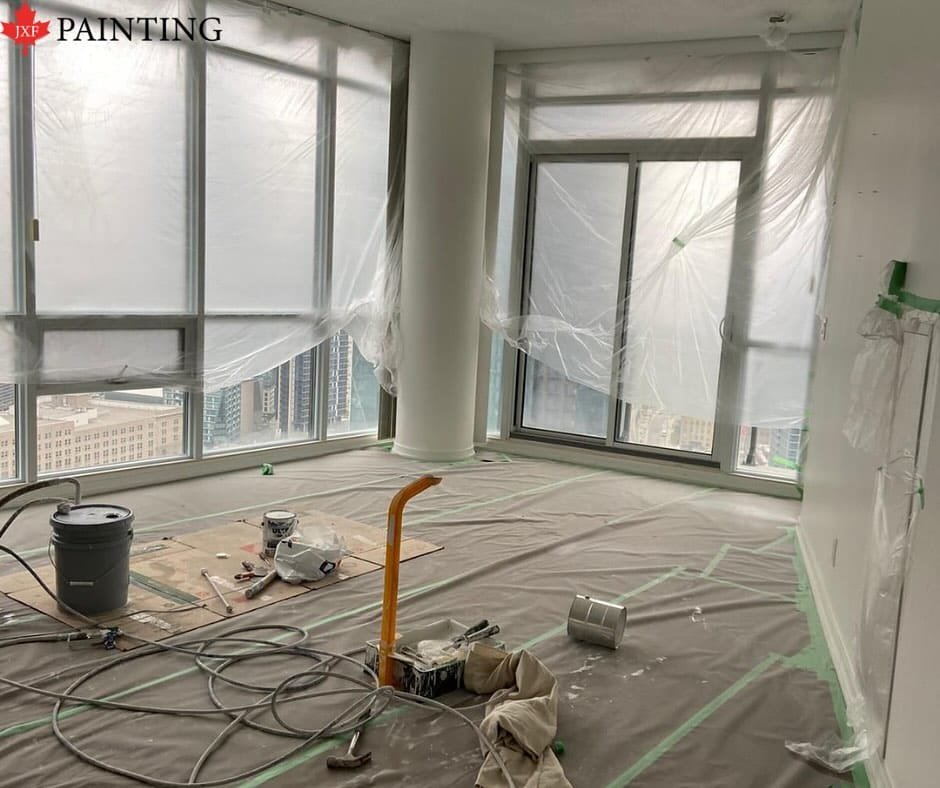Interior house paintings are not intuitive, despite appearances. Most of us are familiar with applying paint on a flat surface, which we learned in kindergarten with finger painting. On the other hand, a truly competent interior paint job is quite another matter.
Use these tactics on your next interior painting project to make it go faster and smoother while producing a cleaner, more appealing result. We’ve developed a list of the nine most significant and helpful interior painting tricks to help you achieve the most outstanding results and a faultless finish so that you can get the same results as the pros.
Clean the Surface with a Tack Cloth
A tack cloth is a low-cost painting product that aids in preparing the surface before painting or staining for flawless results. A beeswax-soaked cheesecloth or tack cloth gently removes sawdust, wood shavings, and other debris from your surface. Using a tack cloth, avoid applying a damp cloth to the surface.
If you don’t have a tack cloth, a damp cloth can suffice, but make sure to squeeze it out thoroughly first. Avoid using a tack cloth on large surfaces, and it works best for trim, doors, and cabinets rather than walls and ceilings. Also, avoid pressing too hard on the tack cloth, as this may cause beeswax to smear on the surface.
Purchase Superior Roller Covers and Brushes
Poor-quality roller coverings leave fuzz and lint on the walls. When fur and lint become embedded in the paint, and the paint dries, the result is harsh, difficult-to-restore walls. Poor-quality brushes leave streaky marks; instead, invest in high-quality brushes and care for your costly investment. Some do-it-yourself painters make the error of buying cheap chip brushes.
The interior painting tricks should not be done using chip brushes; they are designed for applying glues, adhesives, and solvents. It is worthwhile to invest in higher-quality roller covers and brushes. In the end, your surface will look better.
Buy High-Quality Paint
What is the difference between one paint advertised for a price and another seemingly comparable paint for five times the price? The most affordable paints are often builder’s grade paints with fewer solids than higher quality paints. Solids are what make an excellent paint build.
Builder’s grade paints, such as Sherwin-Williams ProMar 400 Interior Latex and Valspar Professional Interior Latex, play an essential part in quick, low-cost, low-commitment paint jobs if you want to paint anything that will last, invest in higher-quality paint.
The Duct Tape Test Is Used To Check For Loose Paint
Will the existing painted surface accept new paint and retain it for years? While it is hard to foretell the future, checking a character with duct tape can give a decent indication of its quality. Lay a new strip of duct tape over the affected area, then rip it off. If larger than microscopic paint flakes fall off, you may need to scrape and then sand.
Latex or Nitrile Gloves Should be Used
While painting, latex gloves are ideal for keeping your hands clean. Water-based interior latex paint readily cleans off hands, while cleaning enamel or oil-based paint might be difficult. If you do not like latex gloves or are allergic to them, you can substitute nitrile gloves.
Apply Low-Stick Painter’s Tape liberally
Painter’s tape, often known as blue tape, is a low-stick adhesive that is easy to remove and will not rip off existing paint or primer. While painter’s tape can be costly, it is worth the investment to generously apply it to the edge of all surfaces that will not be painted, such as the joint between walls and ceilings.
Maintaining A Wet Edge When Rolling A Wall
When painting a room, permanently preserve a wet edge and work away from it. The more glossy the paint, the more probable overlap markings will be seen. Semi-gloss and shiny colours, in particular, necessitate careful attention to maintaining a moist edge. However, when using flat or matte paint, there is essentially little possibility of generating overlap marks.
Cover Clean Areas With Masking Film
Masking film is a hidden technique that skilled painters regularly employ but that many do-it-yourself painters are unaware of. Masking film is a thin plastic sheet that comes in rolls or folded squares. Masking film is a thin plastic sheet that comes in rolls or squares that have been folded up.
Its thinness is critical to its success. Masking film, unlike thicker plastic sheeting often used to cover furniture, clings and sticks to flat surfaces on its own. Unless the film is close to the edge of a painted surface, there is no need to tape it down. Static electricity holds the masking movie in place.
Avoid Cleaning by Wrapping the Brush or Roller
You must deal with tidying up and cleaning at the end of your painting day. Cleaning the brushes and rollers is something that many people detest. Meetings can be tough to clean, but a paint comb can help. Cleaning roller coverings is more complex: no matter how much you wash the roller, it tends to dry out too stiff to use again.
However, there is one trick to avoiding this cleaning. If you know you’ll be back to your work soon; you can keep your roller cover or brush with the paint still in it by:
- Wrap the brush or roller in a plastic bag and place it in the freezer. This should keep the brush or roller in good condition indefinitely. Allow plenty of time for the roller cover or brush to defrost before using them again; alternatively.
Wrapping Only: If you don’t want to put brushes or roller coverings in a flood zone, wrap them in plastic and store them outside at an average temperature.
Interior Painting Tricks by JXF Painting
Ensure that the plastic is airtight. This should keep the brush or roller cover in place for the day. If the wrap is exceptionally tight, you may be able to postpone it until the next day. Please get in touch with us at (647) 889-7967 or email info@jxfpaintingservice.ca.




